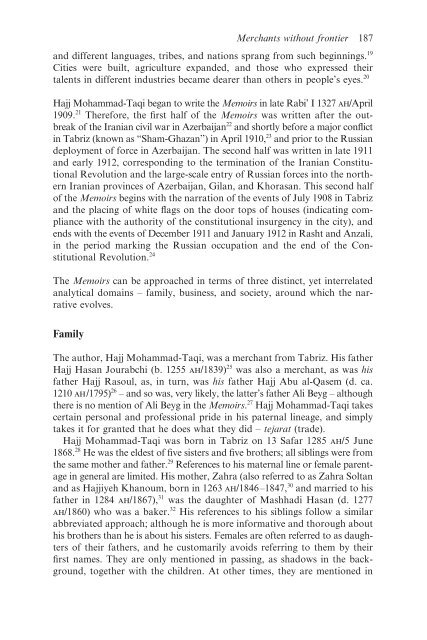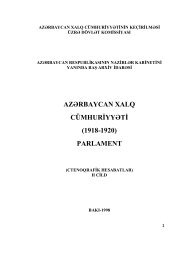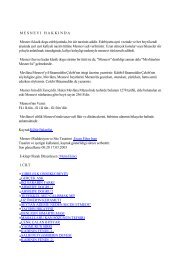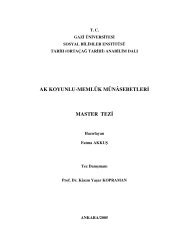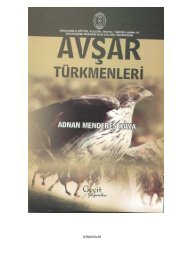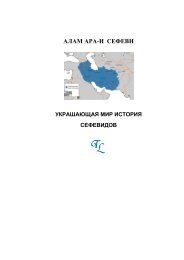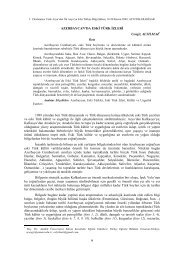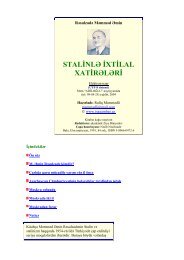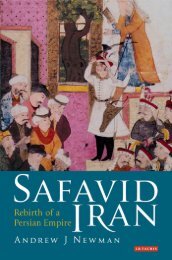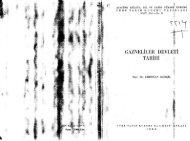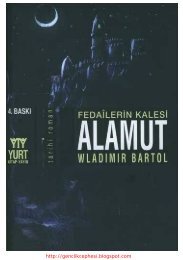War and Peace in Qajar Persia: Implications Past and ... - Oguzlar.az
War and Peace in Qajar Persia: Implications Past and ... - Oguzlar.az
War and Peace in Qajar Persia: Implications Past and ... - Oguzlar.az
- No tags were found...
You also want an ePaper? Increase the reach of your titles
YUMPU automatically turns print PDFs into web optimized ePapers that Google loves.
Merchants without frontier 187<strong>and</strong> different languages, tribes, <strong>and</strong> nations sprang from such beg<strong>in</strong>n<strong>in</strong>gs. 19Cities were built, agriculture exp<strong>and</strong>ed, <strong>and</strong> those who expressed theirtalents <strong>in</strong> different <strong>in</strong>dustries became dearer than others <strong>in</strong> people’s eyes. 20Hajj Mohammad-Taqi began to write the Memoirs <strong>in</strong> late Rabi’ I 1327 ah/April1909. 21 Therefore, the first half of the Memoirs was written after the outbreakof the Iranian civil war <strong>in</strong> Azerbaijan 22 <strong>and</strong> shortly before a major conflict<strong>in</strong> Tabriz (known as “Sham-Gh<strong>az</strong>an”) <strong>in</strong> April 1910, 23 <strong>and</strong> prior to the Russi<strong>and</strong>eployment of force <strong>in</strong> Azerbaijan. The second half was written <strong>in</strong> late 1911<strong>and</strong> early 1912, correspond<strong>in</strong>g to the term<strong>in</strong>ation of the Iranian ConstitutionalRevolution <strong>and</strong> the large-scale entry of Russian forces <strong>in</strong>to the northernIranian prov<strong>in</strong>ces of Azerbaijan, Gilan, <strong>and</strong> Khorasan. This second halfof the Memoirs beg<strong>in</strong>s with the narration of the events of July 1908 <strong>in</strong> Tabriz<strong>and</strong> the plac<strong>in</strong>g of white flags on the door tops of houses (<strong>in</strong>dicat<strong>in</strong>g compliancewith the authority of the constitutional <strong>in</strong>surgency <strong>in</strong> the city), <strong>and</strong>ends with the events of December 1911 <strong>and</strong> January 1912 <strong>in</strong> Rasht <strong>and</strong> Anzali,<strong>in</strong> the period mark<strong>in</strong>g the Russian occupation <strong>and</strong> the end of the ConstitutionalRevolution. 24The Memoirs can be approached <strong>in</strong> terms of three dist<strong>in</strong>ct, yet <strong>in</strong>terrelatedanalytical doma<strong>in</strong>s – family, bus<strong>in</strong>ess, <strong>and</strong> society, around which the narrativeevolves.FamilyThe author, Hajj Mohammad-Taqi, was a merchant from Tabriz. His fatherHajj Hasan Jourabchi (b. 1255 ah/1839) 25 was also a merchant, as was hisfather Hajj Rasoul, as, <strong>in</strong> turn, was his father Hajj Abu al-Qasem (d. ca.1210 ah/1795) 26 – <strong>and</strong> so was, very likely, the latter’s father Ali Beyg – althoughthere is no mention of Ali Beyg <strong>in</strong> the Memoirs. 27 Hajj Mohammad-Taqi takescerta<strong>in</strong> personal <strong>and</strong> professional pride <strong>in</strong> his paternal l<strong>in</strong>eage, <strong>and</strong> simplytakes it for granted that he does what they did – tejarat (trade).Hajj Mohammad-Taqi was born <strong>in</strong> Tabriz on 13 Safar 1285 ah/5 June1868. 28 He was the eldest of five sisters <strong>and</strong> five brothers; all sibl<strong>in</strong>gs were fromthe same mother <strong>and</strong> father. 29 References to his maternal l<strong>in</strong>e or female parentage<strong>in</strong> general are limited. His mother, Zahra (also referred to as Zahra Soltan<strong>and</strong> as Hajjiyeh Khanoum, born <strong>in</strong> 1263 ah/1846–1847, 30 <strong>and</strong> married to hisfather <strong>in</strong> 1284 ah/1867), 31 was the daughter of Mashhadi Hasan (d. 1277ah/1860) who was a baker. 32 His references to his sibl<strong>in</strong>gs follow a similarabbreviated approach; although he is more <strong>in</strong>formative <strong>and</strong> thorough abouthis brothers than he is about his sisters. Females are often referred to as daughtersof their fathers, <strong>and</strong> he customarily avoids referr<strong>in</strong>g to them by theirfirst names. They are only mentioned <strong>in</strong> pass<strong>in</strong>g, as shadows <strong>in</strong> the background,together with the children. At other times, they are mentioned <strong>in</strong>


